JPD History
The following historical information is from the "History of Jaffrey, New Hampshire Vol. IV" , the Jaffrey History Committee, and our own recollections.
"We judge ourselves by what we feel capable of doing, but others judge us by what we have already done." - Count Leo N. Tolstoi
The early history of the Jaffrey Police Department is very vague for many reasons. Minimal exposure to crime and poor record keeping are just two.
In 1836 the town purchased a farm on Old Peterborough Road. This "town farm" is of significance to the police department because of the purpose it served. The town farm was a refuge for poor, homeless individuals. In exchange for their labor, they were provided food and shelter. Two cages were placed on the town farm property to confine "lawbreakers" and "disorderly tramps". Thus, the first lockup facilities were born.
In 1869 the state provided a county farm/jail in Westmoreland, New Hampshire, a concept that survives to this day. Jaffrey's prisoners were sent to Westmoreland or, in some cases, to the lockup in Keene. The town sold the town farm. The cages were retained and placed in what was known at the time as the "tramp house" at the end of Blake Street. This structure, located behind the railroad depot, was utilized as a temporary holding facility for Jaffrey prisoners.
The earliest record of a Jaffrey Chief of Police was Nahum Washington Mower in 1884. It is interesting to note that Chief Mower received an annual salary of $5.00 as police chief and $20.00 annually for ringing the town bell!!
In 1890 the first Jaffrey Police Department was recorded. Chief Harlan Franklin Hodge had two part-time officers, W.W. Heath and W.A. Lakin, under his command.
Little is known about our police history and chiefs of police until 1909. In that year Chief P.N. Proctor was replaced by Chief C. L. Stratton. Chief Stratton was succeeded by Chief Edward Leighton in 1911. In 1913 George I. Nute was elected as the first full-time chief of police. Chief Nute produced the first Report of the Chief of Police that same year. The total police operating budget was $740.77.
In 1917 Chief Nute set up the first Jaffrey Police Department lockup and courtroom in the basement of the Duncan Block, located at the corner of Main and River streets. He was also responsible for initiating the first Jaffrey police communications center. In 1916, after considerable time and persuasion, Chief Nute convinced the town to provide the police department with a telephone. In 1919 Chief Nute was replaced by Chief J.J. Mahoney.
In 1922 the tenure of Chief Hubert F. O'Neil began. Chief O'Neil remained chief until 1954. His 32 years at the helm is a record not seen before or since. Jaffrey bought its first police cruiser, a 1946 Ford, that was given to Chief O'Neil on his retirement in 1954.
In August 1923 Jaffrey celebrated its sesquicentennial. Thousands of people flocked to Jaffrey for a weeklong celebration and events. Chief O'Neil received the assistance of several part-time officers to assure things went smoothly. The extra protection cost the town $118.50, a considerable sum of money in 1923.
With increased mobility, crime was on the upswing, and Chief O'Neil's work load grew, requiring the addition of night officers, Arthur Baldwin and Joseph Lemire. Chief O'Neil's daughter, Katherine Christian, recalled a night when he came home, face bloodied, glasses broken, shaking his head and simply asking, "Why?" His question is just as poignant today. This solid, always giving member of the community was succeeded by the first appointed chief of police.
In May 1954 Lucien Vigneault succeeded Hubert O'Neil as head of the Jaffrey Police Department. Chief Vigneault, a native of Nashua, was a strong presence in town. In 1955 a new structure to house the town office, court, and police department was built. On September 1, 1965, Chief Vigneault suffered a fatal heart attack. The department was shocked and saddened by the sudden loss of its leader.
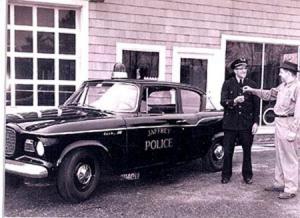
Roland W. Desrosiers presenting Chief Lucien Vigneault with the keys to the new cruiser, 1960
The department has grown considerably since Chief Arthur Rivard succeeded Lucien Vigneault in 1965. By 1970 the department had six police officers and several part-time officers. Edith A. Peard was the police matron for many years, and longtime residents will remember Special Police Officer Arthur H. Hunt directing church traffic and patrolling every Sunday morning.
August 19, 1981, marked the saddest day in Jaffrey Police history to date. In the wee hours of the morning, while responding to back up his partner on a burglary-in-progress call, Supervisor William E. O'Neil, Sr. gave his life in the line of duty. He is the only Jaffrey officer to have done so. He was killed when the cruiser he was driving skidded out of control into a tree on Turnpike Road just east of the Silver Ranch area.
Thirty-eight-year-old "Bill" O'Neil was a six-year veteran of the department, a loving husband and father of two children, ages 12 and seven at the time of his death. He was a grandson of Chief Hubert O'Neil. Officer O'Neil's funeral at the Rindge Congregational Church was attended by police officers from all over the Northeast. He was laid to rest on a warm summer day, just the kind of day he so enjoyed sharing with his young family. Friends and family members fondly remember Bill as a "gentle giant," who stood about six feet four and weighed over 200 pounds. His presence was certainly felt, for he was a warm and caring person.
Chief Rivard announced his retirement in early 1982. Barry E. Sasner, a supervisor and seven-year member of the force, served as acting chief of police during the search for Chief Rivard's replacement. Acting Chief Sasner would leave law enforcement during the tenure of his successor and go on to become the Jaffrey Town Clerk until his untimely passing in August 1987.
Leonard DiMarco, who had served as a member of the Detroit, Michigan, Harbor Police and as a chief of police in Livermore Falls, Maine, became the new chief in September 1982. Chief DiMarco's vision for the department was much different from that of his predecessors. Setting and achieving very high standards and becoming a source of community pride were phrases he used in his first and only annual report to the Town of Jaffrey. Less than a year later Chief DiMarco resigned his post in the midst of allegations of wrongdoing. The department, after losing veteran members and feeling the effects of the quick departure of its leader, was once again searching for a chief of police. Sergeant David Roberts was designated as "Sergeant in Charge" during this period of time. He would go on to become chief of police in Litchfield, New Hampshire, in 1985.
Well-known and popular with residents of the community, Eugene F. "Skip" O'Brien would become the next chief. Chief O'Brien had served as a New Hampshire State Trooper, assigned to the Keene barracks for several years prior to his appointment. In 1984 the police department moved from its basement quarters at the Town Office to the former Jaffrey Fire Station on River Street. One garage bay was left intact, the other converted into offices and holding cells.
Called a temporary move at the time, the building would serve as the police station for the next 12 years. Chief O'Brien resigned in 1986. His sergeant, Clinton Simmons, served as acting chief until September 1, 1987.
Outspoken and dynamic, David T. Barrett was Chief O'Brien's successor. He had worked in California and New Hampshire law enforcement environments before coming to us. A more sophisticated style of policing was evident under his tenure, different from what Jaffrey had experienced before. The department grew to a total of 11 full-time officers, supplemented by part-time officers, two full-time desk officers, and an animal control officer during his tenure. He believed in bringing people through the ranks in the department, and upon his resignation in 1992 was proud that his successor would be the man he appointed as lieutenant, Gary A. Phillips.
In March 1996 the police department moved from its quarters in the old firehouse to the former Town Office building on Memorial Square. The department occupies the entire building, which was renovated into a state-of-the-art police station, yet still retains small-town charm. Among the decorative touches are a painting of the department shoulder patch done by a Franklin Pierce College art student and a mural, created by Conant High School students, depicting the locations of the department since 1955.
Chief Phillips resigned his post in March 1997 and was succeeded by Robert A. Pelio, a native of Long Island, New York, had been a member of the department since 1985 and worked his way up the ranks of the department. He is best known for his thorough and aggressive investigation of child abuse and domestic violence crimes. Chief Pelio is well-educated, highly respected, and always mindful of the community's needs both now and for the future.
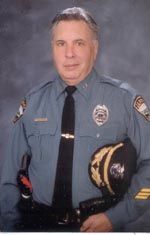
Chief Robert A. Pelio
Chief Pelio was instrumental in bringing about a change in the way district court cases are handled for the Jaffrey and Peterborough police departments. After several months of intensive study and meetings between the leaders of both communities, the decision to hire a police prosecutor was made. Tracy A. Connolly, an attorney with the Rockingham County Attorney's office, was chosen from a field of talented candidates. Attorney Connolly prosecuted cases for both towns, and in October 1998 she assumed the same duties for the Dublin Police Department. Shortly thereafter Attorney Connolly was replaced with Attorney David Park, a former Cheshire County Attorney. In 2001 the Rindge Police Department joined the "regional prosecutor program". This included a full-time legal secretary and as of May 2002 an additional secretary was hired for 10 hours a week.
During the later part of 2001 and beginning of 2002, the Jaffrey Police Department increased its efforts in community relations and community policing. This included seminars and classes to area residents and businesses covering topics from shoplifting and fake identifications, alcohol and drug recognition, driver education for senior citizens and self-defense classes. The first "Police Trading Cards" were also implemented and have been extremely successful, especially with the youth.
In May 2002, the Jaffrey Police Department took a huge jump into the technology world by installing computers and the necessary software in the cruisers and communications center allowing the officers to talk to each other via e-mail and to run motor vehicle records while in the field. This has significantly enhanced their ability to perform their job safer and more effectively.
In June 2002, Chief Pelio retired from the department after serving 20 years in law enforcement. He was replaced by Chief Martin Dunn who came to the department from New Jersey with 28 years of police experience in a diversity of assignments. He has been very active with coordinating Community Policing projects, especially school based or youth programs.
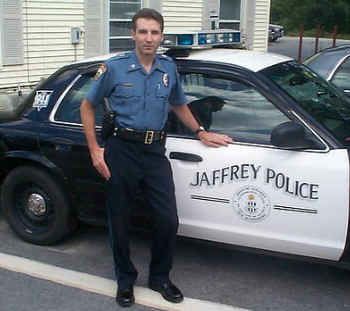
Chief Martin J. Dunn
Chief Dunn expanded efforts to improve technology within the department. Mobile computers were installed in all cruisers allowing officers to instantly access criminal records, along with portable cell phones they could take with them on calls for service. A four-wheel drive vehicle was acquired to assist with responding to calls during winter weather challenges. That vehicle was also adapted for use as a mobile command center. A new telephone / radio recording device, in house video recording system and computers were also acquired.
In September 2003 the Jaffrey Police Department hosted its first Citizen's Police Academy. This consisted of 10 citizens who attended an 11 week program involving classes on patrol tactics, DWI recognition, evidence recovery and processing, criminal procedures, handcuffing and defensive tactics, demonstrations by NH State Police K9 and SWAT Units and a tour to the Cheshire County House of Corrections, as well as other areas of training. This was hopefully the first of many in what turned out to be a very successful program geared towards bridging the gap between police and citizens. This program was established and organized by Sgt. Feyrer.
In December 2003, Sgt. Steven Reynolds retired after 22 years of service. He was active in the DARE program and served as the department's School Resource Officer for several years.
Officers received new service weapons and bullet proof vests in 2004, replacing guns that were more than 15 years old and vests that had questionable reliability. All officers were issued personal safety equipment and provided with additional firearms proficiency training.
In 2005, after earning a law degree, Lt. Carpenter transferred to the Regional Prosecution Program to perform those duties fulltime. Sgt. Oswalt was promoted to Lt. and assumed the roll of 'second in command'. Sgt. Feyrer resigned to accept an appointment as chief of police in another agency and Sgt. S. Dunn left soon after to serve with him. Ptlm. Prince and Tucker were promoted to Sergeant to fill those openings.
New state of the art RADAR units and light bars were installed in all cruisers. Cruisers were also equipped with the Project 54 technology allowing officers to activate police equipment in the cruisers by voice, thus enhancing officer safety. The mobile data terminals in the cruisers were also upgraded with new computers.
A mobile speed trailer was also acquired through grant funds as a means of increasing highway safety in Jaffrey. Having this instrument allowed officers to alert large numbers of motorists of the speeds their vehicles were traveling so they could adjust them when necessary.
Today's Jaffrey Police Department has evolved into a department proud of being a vital part of the community, embracing proactive rather than reactive policies. The department is active in youth programs, foot and bicycle patrols, interaction with other civic groups, and traditional law enforcement. The department has conducted many investigations into major criminal cases. The department is known as one of the best in New Hampshire and counts among its ranks officers who regularly teach at the New Hampshire Police Academy, Franklin Pierce College, and are leaders in the fields of investigation of child abuse, domestic violence, youth aid, drug crimes, school violence, and other areas.
In 1987 the Jaffrey Police Department changed the cruisers from white with a blue stripe (no photo available) to the traditional black and white cruiser. This paint scheme remained constant until its recent change in 2002.
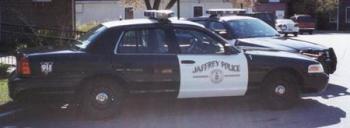
Paint Scheme from 1987-2002
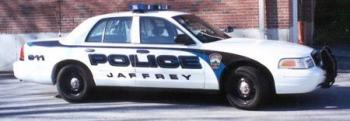
Paint Scheme 2002

